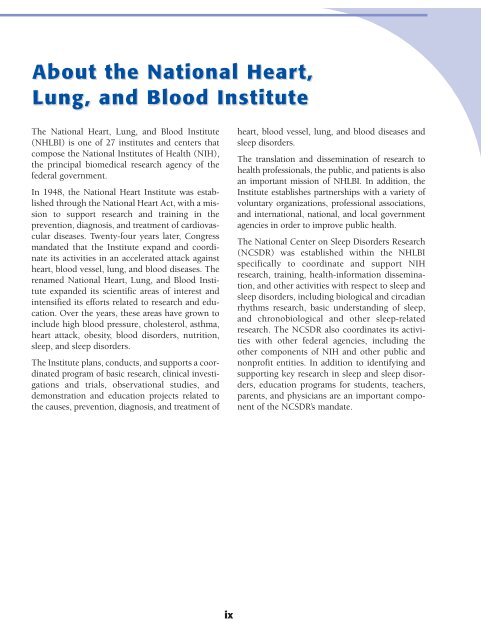Biological - NIH Office of Science Education - National Institutes of ...
Biological - NIH Office of Science Education - National Institutes of ...
Biological - NIH Office of Science Education - National Institutes of ...
You also want an ePaper? Increase the reach of your titles
YUMPU automatically turns print PDFs into web optimized ePapers that Google loves.
About the <strong>National</strong> Heart,<br />
Lung, and Blood Institute<br />
The <strong>National</strong> Heart, Lung, and Blood Institute<br />
(NHLBI) is one <strong>of</strong> 27 institutes and centers that<br />
compose the <strong>National</strong> <strong>Institutes</strong> <strong>of</strong> Health (<strong>NIH</strong>),<br />
the principal biomedical research agency <strong>of</strong> the<br />
federal government.<br />
In 1948, the <strong>National</strong> Heart Institute was established<br />
through the <strong>National</strong> Heart Act, with a mission<br />
to support research and training in the<br />
prevention, diagnosis, and treatment <strong>of</strong> cardiovascular<br />
diseases. Twenty-four years later, Congress<br />
mandated that the Institute expand and coordinate<br />
its activities in an accelerated attack against<br />
heart, blood vessel, lung, and blood diseases. The<br />
renamed <strong>National</strong> Heart, Lung, and Blood Institute<br />
expanded its scientific areas <strong>of</strong> interest and<br />
intensified its efforts related to research and education.<br />
Over the years, these areas have grown to<br />
include high blood pressure, cholesterol, asthma,<br />
heart attack, obesity, blood disorders, nutrition,<br />
sleep, and sleep disorders.<br />
The Institute plans, conducts, and supports a coordinated<br />
program <strong>of</strong> basic research, clinical investigations<br />
and trials, observational studies, and<br />
demonstration and education projects related to<br />
the causes, prevention, diagnosis, and treatment <strong>of</strong><br />
heart, blood vessel, lung, and blood diseases and<br />
sleep disorders.<br />
The translation and dissemination <strong>of</strong> research to<br />
health pr<strong>of</strong>essionals, the public, and patients is also<br />
an important mission <strong>of</strong> NHLBI. In addition, the<br />
Institute establishes partnerships with a variety <strong>of</strong><br />
voluntary organizations, pr<strong>of</strong>essional associations,<br />
and international, national, and local government<br />
agencies in order to improve public health.<br />
The <strong>National</strong> Center on Sleep Disorders Research<br />
(NCSDR) was established within the NHLBI<br />
specifically to coordinate and support <strong>NIH</strong><br />
research, training, health-information dissemination,<br />
and other activities with respect to sleep and<br />
sleep disorders, including biological and circadian<br />
rhythms research, basic understanding <strong>of</strong> sleep,<br />
and chronobiological and other sleep-related<br />
research. The NCSDR also coordinates its activities<br />
with other federal agencies, including the<br />
other components <strong>of</strong> <strong>NIH</strong> and other public and<br />
nonpr<strong>of</strong>it entities. In addition to identifying and<br />
supporting key research in sleep and sleep disorders,<br />
education programs for students, teachers,<br />
parents, and physicians are an important component<br />
<strong>of</strong> the NCSDR’s mandate.<br />
ix

















